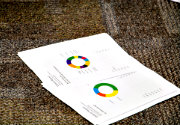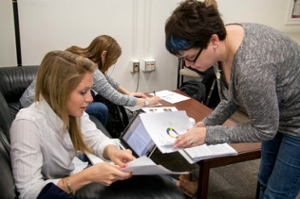Reframe Podcast: Episode 8

Surviving Breast Cancer Together: The Family Science Behind Chronic Illness

Elise Radina, Professor and Chair of the Department of Family Science and Social Work, currently oversees a comprehensive research effort to understand how the diagnosis, treatment and survivorship of breast cancer impacts family life.
James Loy:
This is Reframe, The podcast from the College of Education, Health and Society on the campus of Miami university.
When a person falls ill, they rarely suffer alone. Very often the psychological and emotional impacts of long-term disease can affect the entire family. So in this episode we take a closer look at a new theory called the Health-Related Family Quality of Life.
In many ways, families are like an organic tapestry, an interconnected web of life, each thread related to the next in some manner. As one life touches another, many of these connections may be substantial, others may be somewhat insignificant, or even nearly invisible. But nonetheless, together they all form a larger system that is comprised of many dynamic and individual parts. And when one thread is pulled or damaged or diseased, it will inevitably have an effect on the whole unit.
When considering the diversity and complexity of most family structures, comprehending the extent of these reverberant effects is not yet well understood. But after a member of her own family became afflicted with a disease, Lindsay Clark, a Miami University undergraduate, became interested in the research that was designed to explore such connections further.
Clark followed a friend’s recommendation to visit Dr. Elise Radina, a Miami University Professor and Chair of the Department of Family Science and Social Work, who currently oversees a comprehensive research effort to understand how the diagnosis, treatment and survivorship of breast cancer impacts family life.
The work centered around a concept Dr. Radina herself had developed, a model called the Theory of Health-Related Family Quality of Life, which seeks to understand how the survivorship of a long-term individual illness, such as breast cancer, affects the overall quality of family life as a unit.
Before her theory was first published in the Journal of Family Theory & Review back in 2013, academic research, up to that point, had neglected this area of family science.
On one side, there was existing research that studied how health, long-term illnesses, and survivorship affected the quality of life for individuals. And on the other side, there was some research that looked at family quality of life as a very broad and general concept. But Dr. Radina recognized the need to close the gap between the two.
Elise Radina:
Really what I did was, I took ideas that were hiding in different theories, and brought them together to create a new theory. And when it comes to family quality of life research, there is the family quality of life stuff, and then there is the individual health quality of life. So you either talk about how families are functioning well, and how happy they are, or not happy. Or, you talk about something related to, you know, I have cancer or I have diabetes or whatever, and what’s my quality of life with that particular condition. And what I was trying to do was bring those two together into a theory that looks a health and family in a more intermixed global way.
James Loy:
At its core, The Theory of Health-Related Family Quality of Life acknowledges that during instances of long-term illnesses, the individual is not the only person who is affected. Because most individuals are part of a larger family structure, the interconnected nature of this system means that all family members will mutually influence each other in a variety of ways.
In her original article, Dr. Radina explains how it is appropriate to apply the theory in ways that go beyond the patient as the central unit of study. She wants to include multiple family members and multiple perspectives, to gain a clearer picture of the family-level impacts of breast cancer diagnosis, treatment, and survivorship.
In order to pull the lens back and gain a glimpse of this larger picture, the Theory of Health-Related Family Quality of Life utilizes three conceptual pillars including emotional closeness, family sense of coherence, and family functioning, which all zero in on different psychological and interpersonal aspects of the family dynamic. And though the theory can just as easily be applied to diabetes and various cardiovascular diseases, for example, Dr. Radina focused breast cancer because, according to the American Cancer Society, it is not only one of the most common forms of cancer, it is also increasingly associated with survivorship.
As a theory, the model is expansive, and Dr. Radina is currently employing its framework to further understand how health-related family quality of life actually unfolds in real-world settings. And to this end, she is continuing an ongoing line of projects aimed at exploring each of the theory’s three pillars in more depth and detail.
The particular project Lindsay Clark joined as an undergraduate researcher focused specifically on the “emotional closeness” pillar, and it was a natural continuation of the original work Dr. Radina had begun while first collecting the qualitative breast cancer survivor data she used to generate the theory in the first place.
Elise Radina:
The theory was born, or was gestating, as I was creating the interview guide to collect this data. So it really guided what kind of information we collected. So then I say okay, we have the theory, now we have this data, let’s see if the theory bears itself out in the data. And so then the data here helped us understand parts of the theory.
James Loy:
The idea was to test, build upon, and further develop the emotional closeness pillar, to make a substantial step toward the validation of the theory as a whole. And along with Lindsay Clark, the project also involved a number of additional undergraduate researchers.
Elise Radina:
This project is something that I have been doing with undergraduate students for a long time. We used qualitative data analysis software, I trained the students how to use it and how to code, and to clean up the codes and the code book, and the whole deal.
James Loy:
The team utilized the theory as a framework to explore how the diagnosis, treatment, and recovery of breast cancer changes the perception of family quality of life, especially as it related to feelings of emotional satisfaction. Open-ended questions were used to encourage a discussion of survivors’ experiences with breast cancer, family life, the decision-making process, personal coping techniques, and more.
They were also asked very specific questions about their perceived quality of family life both before and after the diagnosis.
It was important to address any potential changes in perception because the researchers wanted to move beyond the casual claims of people who often say things like, for example, “The disease brought us closer together as a family.” Or, “We appreciate each other so much more now.” And so on.
Elise Radina:
And you hear that anecdotally all the time from cancer survivors. But I want to know if that is really a thing? Or is that just how I’m perceiving it now because I’m a survivor now, or whatever. Has it really changed? Or have we . . . are we creating some sort of false something about whether or not it changed. And so I am asking these pointed questions to have them really think about what was it like before and what was it like now.
James Loy:
The team revealed a number of reoccurring subthemes that suggested that most cancer survivors do, in fact, perceive changes in the level of emotional satisfaction and psychological closeness they experienced before, and then after, a breast cancer diagnosis.
The full extent of these findings will soon be published in the undergraduate research journal Compass, and it’s a body of work that actually fulfills several key functions, both for Dr. Radina’s students and for the field of family science at large.
First, it is a step toward a fuller understanding and a more complete application of the theory, which could soon be used to help healthcare professionals better assist families managing disease and illness.
Elise Radina:
Ultimately what this will lead to, and I am in the process of doing this now, is an instrument that will measure these concepts. And so . . . that will basically be able to do a quantitative testing of the theory. So this helped us to get from the theory to understanding the concepts better, so that we can then create an instrument that we can use in a larger quantitative study to test the theory. And we are actually in the process of doing that instrument development right now.
James Loy:
Doctors, nurses, social workers, and mental health professionals, for example, could potentially use such an instrument to measure a family’s quality of life, and then increase positive outcomes by intervening with any preventative measures, educational materials, or coping strategies as needed.
Secondly, the project also served as a unique learning opportunity for the students themselves. One that, as undergraduates, would rarely be afforded at many other institutions until at least the graduate level in most cases.
But at Miami, they learned how to submit an Institutional Review Board, or IRB, proposal, how to interview participants, and how to manage confidentiality. They also learned critical listening skills and qualitative data analysis methodologies, as well as just how exhaustive the research process very often is.
Being a science major, Lindsay Clark gained valuable insight into the publication process itself. But the leadership and interpersonal skills she learned are also equally essential to many other students, especially those pursuing careers in family science and social work.
Elise Radina:
Many of my students want to go into some sort of helping profession and, often times, a health related profession. And they say, ‘What I have learned from listening to people’s stories has helped me to think about how I am going to be in that job.’ It is not just about the clinical things they learn. They understand that there is a backstory, and they learn how to talk to people about their backstory having done this.
James Loy:
In their classes, students talk about challenging experiences, and about how to respond to those challenges. But being able to actually talk to people and to read the transcripts, to see how having a chronic condition actually does impact the family structure, from real people and not just quotes in a text book, is real life experience. And they get to apply what they learned, while gaining an appreciation for the process of generating new knowledge at the same time
And therein lies yet another key skill that Dr. Radina’s students glean.
Here, even at the undergraduate level, the goal is to encourage students to become producers of knowledge, to see themselves as creators, to better understand how we know what we know and just where all these ideas come from.

